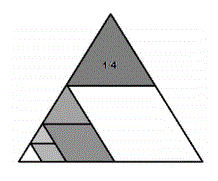| Problem |
Hint |
|
1) Your classmate is thinking of a 2-digit prime number. She tells you that the product of the
two digits is 24. What is the number?
|
Method 1 Write out the 2-digit primes:
11 13 ___ ...
Find a prime whose digits multiply to 24 = _____
Method 2 Write out the 2-number factors of 24:
Find 2 that, when put together, make a prime number.
Number = _____
Note: Method 2 is your only choice if you don't know your 2-digit primes!
|
2) At a small private school 60% of the students are girls. 10% of the boys have blue eyes. 20%
of the girls have blue eyes. What percent of all students have blue eyes? |
1. The boys are ___% of the students.
2. The percent of the total students that are blue-eyed boys = _____%
3. The percent of the total students that are blue-eyed girls = _____%.
4. Add these to get the total = _____%
|
|
3) Your class is having a fundraiser and makes 1000 postcards per student to sell. You sell 32
postcards every day for the first two weeks and 24 postcards every day after that. How many
days will it take you to sell all of the postcards? |
1. Convert 2 weeks to days = ____days.
2. Multiply this by 32 to get the number of postcards sold in 2 weeks = ____ postcards.
3. Subtract this from 1000 = _____ postcards left.
4. Divide this by 24 = _____ days.
5. Add the days together = ____ days.
|
|
4) Tom likes to fill his car with a mixture of premium and regular fuel. Premium fuel costs
$3.25/gallon and regular fuel costs $2.53/gallon. If Tom fills his car with 10 gallons of premium
fuel and 6 gallons of regular fuel, how much does this mixture cost per gallon? |
1. Multiply the cost per gallon times the number of gallons of each grade of gas = $_____
2. Divide by the total number of gallons = _____
|
 5) In the figure, the sum 1/4+ 1/8 + 1/16 + 1/32 +
1/64 represents the area of the shaded regions. If the
total area of the largest triangle is 1 square unit, what
is the area of the unshaded regions?
5) In the figure, the sum 1/4+ 1/8 + 1/16 + 1/32 +
1/64 represents the area of the shaded regions. If the
total area of the largest triangle is 1 square unit, what
is the area of the unshaded regions?
(Express your
answer as a fraction in lowest terms)
|
1. Find the common denominator of the fractional parts = ____ths.
2. Convert all the fractions to this denominator and
add: = _____
3. Subtract this from 1 = _____
|